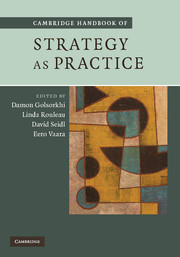Book contents
- Frontmatter
- Contents
- List of figures
- List of tables
- List of contributors
- Introduction: What is Strategy as Practice?
- PART I ONTOLOGICAL AND EPISTEMOLOGICAL QUESTIONS
- 1 Practice in research: phenomenon, perspective and philosophy
- 2 Epistemological alternatives for researching Strategy as Practice: building and dwelling worldviews
- 3 Practice, strategy making and intentionality: a Heideggerian onto-epistemology for Strategy as Practice
- 4 Constructivist epistemologies in Strategy as Practice research
- 5 Constructing contribution in ‘Strategy as Practice’ research
- 6 The challenge of developing cumulative knowledge about Strategy as Practice
- PART II THEORETICAL DIRECTIONS
- PART III METHODOLOGICAL TRACKS
- PART IV APPLICATION VARIATIONS
- Author Index
- Index
- References
1 - Practice in research: phenomenon, perspective and philosophy
Published online by Cambridge University Press: 05 October 2012
- Frontmatter
- Contents
- List of figures
- List of tables
- List of contributors
- Introduction: What is Strategy as Practice?
- PART I ONTOLOGICAL AND EPISTEMOLOGICAL QUESTIONS
- 1 Practice in research: phenomenon, perspective and philosophy
- 2 Epistemological alternatives for researching Strategy as Practice: building and dwelling worldviews
- 3 Practice, strategy making and intentionality: a Heideggerian onto-epistemology for Strategy as Practice
- 4 Constructivist epistemologies in Strategy as Practice research
- 5 Constructing contribution in ‘Strategy as Practice’ research
- 6 The challenge of developing cumulative knowledge about Strategy as Practice
- PART II THEORETICAL DIRECTIONS
- PART III METHODOLOGICAL TRACKS
- PART IV APPLICATION VARIATIONS
- Author Index
- Index
- References
Summary
The focus on practice in management studies – and the strategy field more specifically – is a recent and important development in what organizational scholars pay attention to and how. Reflecting the more general social theoretic ‘practice turn’ (Ortner 1984; Schatzki et al. 2001; Reckwitz 2002), this development is diverse and dynamic, expressing both a range of approaches and a set of emerging possibilities (Gherardi 2006; Malloy 2007; Postill forthcoming; Whittington 2006). Schatzki (2001a, p. 4) argues that given the broad array of interpretations and interests, the most effective notion of practice may be in its framing and orienting of research. It is in this spirit of exploring various ways of structuring practice research that I offer the discussion below, and not to propose or defend any particular conception or appropriation of practice ideas.
In what follows, I want to distinguish three modes of engaging with practice in research, and highlight some of their attending entailments. I will then discuss some of the challenges and implications associated with taking practice seriously in studies of organizations. Throughout this commentary, I will draw on illustrations from the arena of organizational research that I am most familiar with – technology studies. These examples should offer some useful analogies and applications for Strategy as Practice research, where parallel considerations and formations are evident.
- Type
- Chapter
- Information
- Cambridge Handbook of Strategy as Practice , pp. 23 - 33Publisher: Cambridge University PressPrint publication year: 2010
References
- 80
- Cited by



